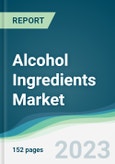The alcohol ingredients market is experiencing robust growth, driven by the global surge in alcoholic beverage consumption, particularly among younger demographics. The market's expansion is fueled by evolving consumer preferences, urbanization, and the increasing popularity of flavored and low-alcohol-content beverages.
Market Drivers
Urbanization and Western Cultural Influence
Rapid urbanization and the adoption of Western culture, particularly in the Asia Pacific region, are significantly boosting the consumption of alcoholic beverages. The young population, a key consumer base, is driving demand for diverse alcoholic products. Changing tastes and preferences are pushing market players to innovate, offering new and varied beverage options to cater to evolving consumer demands. This trend is expected to sustain market growth through the forecast period, as demographic shifts continue to influence consumption patterns.Rising Alcohol Consumption
The global rise in alcohol consumption is a primary driver of the alcohol ingredients market. The proliferation of pubs, nightclubs, and bars has significantly contributed to this trend, promoting the consumption of beverages such as beer, wine, whisky, and vodka, all of which rely on alcohol ingredients for production. The growing popularity of these venues reflects a cultural shift toward social drinking, further amplifying demand for ingredients like yeast, enzymes, and flavorings used in alcohol production. The market is also seeing increased interest in low-alcohol-content beverages, which is expected to drive further development in ingredient innovation and production.Growing Awareness of Flavored Alcohols
Consumer awareness of flavored alcoholic beverages, including mocktails, craft beers, and flavored spirits, is positively impacting market growth. Manufacturers are responding with innovative products that combine colorants, yeast, flavors, and enzymes to meet diverse consumer preferences. Product premiumization is a notable trend, with companies focusing on high-quality, unique offerings to capture the growing demand for craft and flavored beverages. This focus on innovation and premium products is expected to continue driving the alcohol ingredients market forward.Geographical Outlook
North America
North America is poised for significant growth in the alcohol ingredients market during the forecast period. The region is experiencing a surge in alcohol consumption, supported by advancements in production technologies. According to US Census data, in February 2023, sales of beer, wine, and distilled alcohol in the United States reached US$16.40 billion, marking a 1.3% increase over 2022 and an 8.7% increase over 2021 for the same month. The growing number of beer and wine manufacturers, coupled with a rising young population, is further propelling market growth. The Brewers Association reported that in 2022, the total number of operating breweries in the US reached 9,709, reflecting a 3.5% increase, underscoring the region’s strong demand for alcohol ingredients.Key Developments
In March 2023, MONSTER launched “Beast Unleashed,” a new line of alcoholic beverages made from malt alcohol, showcasing the trend toward innovative alcohol products. In January 2023, Bluebird Hardwater introduced three new products under its “hardwater” brand, incorporating ultra-purified distilled water and premium spirits as key ingredients. These developments highlight the industry’s focus on creating novel products to meet consumer demand for unique and high-quality beverages.The alcohol ingredients market is on a strong growth trajectory, driven by rising alcohol consumption, urbanization, and the increasing popularity of flavored and low-alcohol beverages. North America stands out as a key growth region, supported by robust sales and an expanding brewery landscape. With ongoing innovations and a focus on premiumization, the market is well-positioned for sustained growth, catering to the evolving preferences of a young, dynamic consumer base.
Key Benefits of this Report:
- Insightful Analysis: Gain detailed market insights covering major as well as emerging geographical regions, focusing on customer segments, government policies and socio-economic factors, consumer preferences, industry verticals, and other sub-segments.
- Competitive Landscape: Understand the strategic maneuvers employed by key players globally to understand possible market penetration with the correct strategy.
- Market Drivers & Future Trends: Explore the dynamic factors and pivotal market trends and how they will shape future market developments.
- Actionable Recommendations: Utilize the insights to exercise strategic decisions to uncover new business streams and revenues in a dynamic environment.
- Caters to a Wide Audience: Beneficial and cost-effective for startups, research institutions, consultants, SMEs, and large enterprises.
What do businesses use these reports for?
Industry and Market Insights, Opportunity Assessment, Product Demand Forecasting, Market Entry Strategy, Geographical Expansion, Capital Investment Decisions, Regulatory Framework & Implications, New Product Development, Competitive IntelligenceReport Coverage:
- Historical data from 2022 to 2024 & forecast data from 2025 to 2030
- Growth Opportunities, Challenges, Supply Chain Outlook, Regulatory Framework, and Trend Analysis
- Competitive Positioning, Strategies, and Market Share Analysis
- Revenue Growth and Forecast Assessment of segments and regions including countries
- Company Profiling (Strategies, Products, Financial Information, and Key Developments among others.
Segmentation
:By Ingredient
- Yeast
- Enzymes
- Grains and Malts
- Fruits and Sugars
- Botanicals and Spices
- Flavoring Agents
- Coloring Agents
- Others
By Beverage Type
- Beer
- Wine
- Spirits
- RTD Beverages
- Cider
- Others
By Geography
- North America
- USA
- Canada
- Mexico
- South America
- Brazil
- Argentina
- Others
- Europe
- Germany
- France
- United Kingdom
- Spain
- Others
- Middle East and Africa
- Saudi Arabia
- UAE
- Others
- Asia Pacific
- China
- India
- Japan
- South Korea
- Indonesia
- Thailand
- Others
Table of Contents
Companies Mentioned
- Cargill, Incorporated
- Archer Daniels Midland Company
- Kerry Group PLC
- Sensient Technologies Corporation
- Ashland Inc.
- D.D. Williamson & Co., Inc.
- Koninklijke Dsm N.V
- Döhler Group
- Chr. Hansen Holdings A/S
- Treatt PLC
Table Information
| Report Attribute | Details |
|---|---|
| No. of Pages | 152 |
| Published | August 2025 |
| Forecast Period | 2025 - 2030 |
| Estimated Market Value ( USD | $ 3.43 billion |
| Forecasted Market Value ( USD | $ 4.37 billion |
| Compound Annual Growth Rate | 4.9% |
| Regions Covered | Global |
| No. of Companies Mentioned | 10 |









